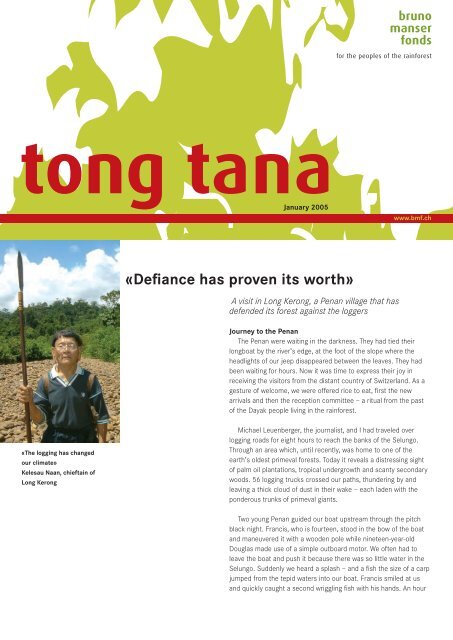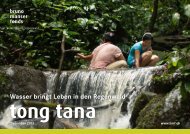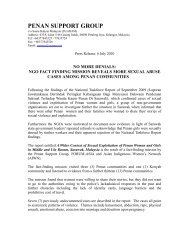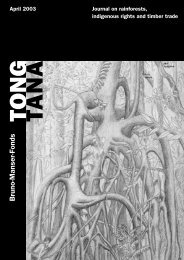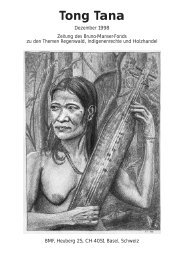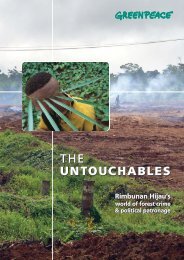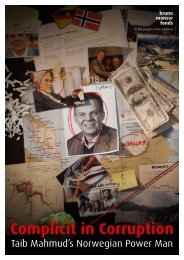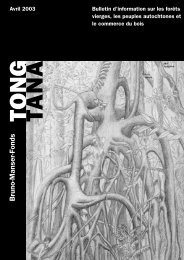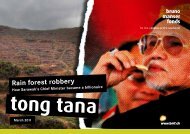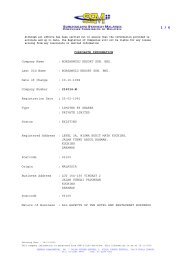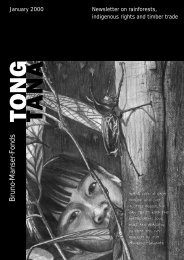tt_0501_e.pdf (737KB) - Bruno Manser Fonds
tt_0501_e.pdf (737KB) - Bruno Manser Fonds
tt_0501_e.pdf (737KB) - Bruno Manser Fonds
Create successful ePaper yourself
Turn your PDF publications into a flip-book with our unique Google optimized e-Paper software.
uno<br />
manser<br />
fonds<br />
for the peoples of the rainforest<br />
tong tana<br />
January 2005<br />
www.bmf.ch<br />
«Defiance has proven its worth»<br />
A visit in Long Kerong, a Penan village that has<br />
defended its forest against the loggers<br />
Journey to the Penan<br />
The Penan were waiting in the darkness. They had tied their<br />
longboat by the river’s edge, at the foot of the slope where the<br />
headlights of our jeep disappeared between the leaves. They had<br />
been waiting for hours. Now it was time to express their joy in<br />
receiving the visitors from the distant country of Switzerland. As a<br />
gesture of welcome, we were offered rice to eat, first the new<br />
arrivals and then the reception commi<strong>tt</strong>ee – a ritual from the past<br />
of the Dayak people living in the rainforest.<br />
«The logging has changed<br />
our climate»<br />
Kelesau Naan, chieftain of<br />
Long Kerong<br />
Michael Leuenberger, the journalist, and I had traveled over<br />
logging roads for eight hours to reach the banks of the Selungo.<br />
Through an area which, until recently, was home to one of the<br />
earth’s oldest primeval forests. Today it reveals a distressing sight<br />
of palm oil plantations, tropical undergrowth and scanty secondary<br />
woods. 56 logging trucks crossed our paths, thundering by and<br />
leaving a thick cloud of dust in their wake – each laden with the<br />
ponderous trunks of primeval giants.<br />
Two young Penan guided our boat upstream through the pitch<br />
black night. Francis, who is fourteen, stood in the bow of the boat<br />
and maneuvered it with a wooden pole while nineteen-year-old<br />
Douglas made use of a simple outboard motor. We often had to<br />
leave the boat and push it because there was so li<strong>tt</strong>le water in the<br />
Selungo. Suddenly we heard a splash – and a fish the size of a carp<br />
jumped from the tepid waters into our boat. Francis smiled at us<br />
and quickly caught a second wriggling fish with his hands. An hour
later, after arriving at Long Sepigen for a stopover, both fi sh had<br />
been fried and landed on our plates.<br />
By foot to village in the tropical forest<br />
On the following day we met with Kelesau Naan, chieftain of the<br />
jungle se<strong>tt</strong>lement of Long Kerong. «Our climate has changed,» he<br />
stated, «since the forest on the lower reaches of our rivers has been<br />
logged. This is the time of the year when we usually have the<br />
greatest rainfall, and now it has not rained for more than a month.»<br />
Long Kerong, a village of 300 inhabitants, is located at the confl u-<br />
ence of the Kerong and the Selungo rivers, some 500 meters above<br />
sea level at the threshold to the mountainous region. Normally, the<br />
village can be reached by longboat. But because the river has so<br />
li<strong>tt</strong>le water, we had to unload our baggage and go by foot for the<br />
next two kilometers.<br />
Welcome dance<br />
by chieftain Bilong Oyoi<br />
for the guests<br />
from Switzerland<br />
As always when he is in the forest, Kelesau Naan took along his<br />
carefully prepared blowpipe, a quiver for arrows and the characteristically<br />
round container for poison. The valuable Ipoh tree grows<br />
here on the upper reaches of the Selungo and provides the Penan<br />
with the deadly poison for their arrows.<br />
Wild boar, deer and monkeys can still be found in large numbers.<br />
And, under the thick treetop foliage, one can still hear the laughing<br />
cry of the hornbill, the increasingly rare heraldic bird of Sarawak.<br />
The 300 Penan of Long Kerong<br />
live in the middle of the rainforest,<br />
250 kilometers from the<br />
nearest city.<br />
Blockades against the bulldozers<br />
The Penan of Long Kerong are aware of the value of their forests.<br />
The village is in the middle of a concession granted to Samling, a<br />
logging corporation with headquarters in the coastal city of Miri.<br />
When employees of the company tried to fell timber in their territory<br />
in 1996/97, the entire village turned to barricades. At fi rst the<br />
Penan tried petitions and negotiations but Samling rejected all of<br />
them. A meeting between the elders and the logging company in<br />
August 1996 came to naught. Samling’s acting manager appeared<br />
at a second meeting with members of the ominous Police Field<br />
Force (PFF).<br />
But the villagers of Long Kerong were not about to be intimidated.<br />
At the beginning of 1997, when Samling was once again<br />
advancing towards their village, the inhabitants blocked the logging<br />
road and stood in the way of the bulldozers in protest at the<br />
destruction of their lebensraum. This time the company appealed<br />
to the military for help. The use of special forces against the<br />
blockade ended with fourteen injured and the arrest of four Penan<br />
on March 13, 1997. Nevertheless, the people of Long Kerong<br />
remained unyielding in their opposition until Samling fi nally withdrew<br />
and sent its bulldozers elsewhere.
Opposition by legal means<br />
To prevent the loggers from making renewed advances into<br />
their territory, Kelesau Naan and the chieftains of three neighboring<br />
villages fi led a suit with the High Court in Miri. The legal action<br />
taken against Samling and the government of Sarawak asserted<br />
that the Native Customary Rights of the Penan indigenous people<br />
have been violated. Based on detailed maps of their traditional<br />
lebensraum, the four villages are claiming an area of about 550 km2<br />
of jungle in the vicinity of their se<strong>tt</strong>lements.<br />
The case is still pending and is being supported by the <strong>Bruno</strong><br />
<strong>Manser</strong> <strong>Fonds</strong>. Until now, it has protected Long Kerong and its<br />
surroundings from another invasion by the loggers. The Court is<br />
expected to consider the case in 2006. In the words of chieftain<br />
Kelesau Naan, «If one considers it in its entirety, we Penan are<br />
claiming only a small piece of land. They should fi nally let us have<br />
it.» And he sums up the long years of rebellion: «Defi ance has<br />
proven its worth. We are glad that we didn’t allow ourselves to be<br />
bought by the logging companies.»<br />
In the meantime we arrived at Long Kerong. Thunder was rolling<br />
from the nearby mountains and before we reached our quarters in<br />
one of the wooden huts it was followed by a torrential downpour.<br />
Our hosts were happy. A sudden change in the weather when<br />
guests arrive is considered a good omen.<br />
Lukas Straumann<br />
The devastation of the rainforest<br />
in the area of the Samling<br />
concession is incalculable.
www.bmf.ch<br />
News in brief<br />
Two Sago palms for <strong>Bruno</strong> <strong>Manser</strong><br />
In memory of <strong>Bruno</strong> <strong>Manser</strong>, who is<br />
considered missing and presumed dead,<br />
Bilong Oyoi, chieftain of the semi-nomadic<br />
Penan, and Lukas Straumann, director of the<br />
BMF, planted two Sago palms close to Long<br />
Kerong in the rainforest of Sarawak. Representatives<br />
of sixteen Penan villages and one<br />
nomadic family took part in the ceremony.<br />
After the trees had been planted, all participants<br />
received a commemorative certificate<br />
wri<strong>tt</strong>en both in Penan and in English. The<br />
Sago palm («Uvut» in Penan) is an important<br />
symbol for the Dayaks whose livelihood<br />
depends on the forest. The mark of the palm<br />
is used as a source of starch, and its<br />
branches serve in the making of blowpipes.<br />
Conclusion of proceedings to<br />
ascertain that <strong>Bruno</strong> <strong>Manser</strong> is<br />
missing and presumed dead<br />
December 31, 2004 marked the expiration<br />
date of the one-year time limit in which to<br />
submit evidence of <strong>Bruno</strong> <strong>Manser</strong>’s possible<br />
whereabouts to the civil court of Basel. If no<br />
credible evidence of his being alive is<br />
submi<strong>tt</strong>ed, <strong>Bruno</strong> <strong>Manser</strong> will be declared as<br />
missing and presumed dead by the Basel<br />
authorities. In all likelihood, the proceedings<br />
will be concluded in March of this year.<br />
Substantial interest for the<br />
Africa rainforest<br />
«The Secret War in the Rainforest», an<br />
event organized by the Basel Africa Commi<strong>tt</strong>ee<br />
and the <strong>Bruno</strong> <strong>Manser</strong> <strong>Fonds</strong>, welcomed<br />
more than 100 participants to Basel on<br />
September 9, 2004. They were interested in<br />
learning at first hand about the clearing of<br />
timber in the rainforest of the Congo Basin<br />
and the violation of human rights resulting<br />
from it. Prosper Nobirabo, the Congolese<br />
lawyer and representative of the «pygmies»<br />
who are especially threatened by the logging,<br />
was invited by the <strong>Bruno</strong> <strong>Manser</strong> <strong>Fonds</strong> to<br />
take part in the podium discussion. Three<br />
themes proved to be of an especially<br />
explosive nature during the course of the<br />
evening: the lack of transparency with regard<br />
to events in the African tropical forest, the<br />
total absence of consideration for the rights<br />
of the aboriginal population of the forests,<br />
and the shifting roles of environmental organizations<br />
in realizing projects within a corrupt<br />
environment.<br />
Swiss communities commi<strong>tt</strong>ed to<br />
the tropical forest:<br />
campaign gains new momentum<br />
Since the publication of our last newsle<strong>tt</strong>er<br />
Tong Tana in the spring of 2004 (and the<br />
English newsle<strong>tt</strong>er in January of 2004), 32<br />
communities have been added to the list of<br />
those which have commi<strong>tt</strong>ed themselves to<br />
respect the integrity of the virgin forests and<br />
to renounce the use of tropical woods from<br />
over-exploitation and from dubious sources.<br />
With the addition of the following, there were<br />
a total of 405 Swiss communities at the<br />
beginning of December:<br />
Gams, Kirchberg (SG); Sa<strong>tt</strong>el (SZ); Lajoux,<br />
Fontenais, Le Bémont, Montignez (JU);<br />
Novazzano, Cureglia, Castel San Pietro (TI);<br />
Châtelat, Leuzigen, Studen, Merzligen,<br />
Worben, Finsterhennen, Detligen, Müntschemier,<br />
Rüderswil, Trub, Radelfingen, Walkringen,<br />
Brügg, Tschugg, Walperswil, Ins,<br />
Dotzigen, Erlach, Rüti bei Büren, Kirchberg,<br />
Wynigen, Evilard (all in BE).<br />
Under the name of «urwaldfreundlich.ch»,<br />
a new organization was founded at the<br />
beginning of October to accelerate the<br />
campaign. In addition to Greenpeace and the<br />
<strong>Bruno</strong> <strong>Manser</strong><strong>Fonds</strong>, which were former<br />
participants, the campaign now includes<br />
WWF Switzerland. Rahel Wunderli of the<br />
<strong>Bruno</strong> <strong>Manser</strong> <strong>Fonds</strong> is assuming responsibility<br />
for it.<br />
Information is available under<br />
www.urwaldfreundlich.ch<br />
<strong>Bruno</strong> <strong>Manser</strong> Diaries: Third edition<br />
is in print<br />
Six months after the publication of<br />
«Tagebücher aus dem Regenwald » [Diaries<br />
from the rainforest] by <strong>Bruno</strong> <strong>Manser</strong>, a third<br />
edition had already gone into print at the<br />
beginning of November. The 4-volume<br />
publication, that includes many illustrations in<br />
color, can be ordered from the <strong>Bruno</strong> <strong>Manser</strong><br />
<strong>Fonds</strong> for CHF 98.- (+ CHF 6.- for handling).<br />
Kindly submit orders by postcard or by e-mail:<br />
bestellungen@bmf.ch.<br />
With heartfelt thanks for your support!<br />
The team of the <strong>Bruno</strong> <strong>Manser</strong> <strong>Fonds</strong><br />
(from left to right):<br />
Christoph Wiedmer, Moni Niederberger-<br />
<strong>Manser</strong>, Rahel Wunderli, Lukas Straumann,<br />
Philipp Juelke, Michael Leuenberger, Nora<br />
Leuenberger, Roger Graf, Dany Endres,<br />
Michel Bovey<br />
Impressum<br />
Tong Tana means «forest» in the language of<br />
the indigenous Penan living in the rainforest of<br />
Sarawak (Malaysia).<br />
Published by the <strong>Bruno</strong> <strong>Manser</strong> <strong>Fonds</strong><br />
Association for the Peoples of the Rainforest<br />
Heuberg 25,CH-4051 Basel, Switzerland<br />
Telephone +41 61 261 94 74<br />
Fax +41 61 261 94 73<br />
E-mail:info@bmf.ch<br />
Internet:www.bmf.ch<br />
Editor:Lukas Straumann<br />
Photographs:Lukas Straumann /BMF<br />
Translation: Mary Louise Me<strong>tt</strong>ler<br />
Graphic design:moxi ltd.,Biel<br />
Printed by Gremper AG,Basel<br />
For donations from Switzerland<br />
and Liechtenstein:<br />
Postal account 40-5899-8<br />
or Bank Coop,CH-4002 Basel<br />
account 421329.29.00.00-5<br />
For donations from France:<br />
La Poste, Strasbourg, N° CCP 2.604.59T


